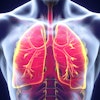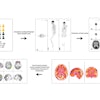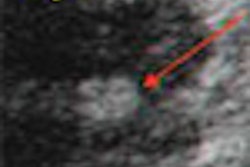Researchers from Boston's Massachusetts General Hospital have concluded that whole-body CT may be a very expensive way to extend lives. Their study examined a hypothetical cohort of 500,000 asymptomatic 50-year-old men, and after projecting the costs of follow-up and treatment, arrived at a price tag of $151,000 for each additional year of life gained as a result of the scans.
No large-scale clinical trials are available to gauge the efficacy of whole-body screening, of course, so the study had to be based on a model -- in essence, a set of projections based on data and decision models for parts of the protocol, cobbled together to depict whole-body scanning on a wide scale.
The paper comes at a time of sharp competition for the hearts and minds of doctors and patients across the U.S. The pro side includes screening interests, who gain financially when consumers buy their services, and who are often eager to trumpet the demonstrated benefits of early detection, which are increasingly difficult to ignore. Leading the charge against whole-body scans are many physicians and healthcare payors who cite the dangers and high potential costs of widespread screening and follow-up among asymptomatic patients. Some are uncomfortable, perhaps justifiably, with the implications of widespread whole-body screening driven by the demands of consumers rather than the views of their physicians. And some direct-to-consumer ads have been found to be inaccurate or misleading.
Others are simply looking for the greatest benefit to society at the lowest cost, a perspective that is quite distinct from that of the individual consumer. The number crunching for the Massachusetts study was painstaking, according to the authors, who sought to measure the effects of whole-body CT from a societal perspective. The researchers went so far as to err in favor of the whole-body scan whenever the available data weren't available or applicable, they said. But the group's Monte-Carlo decision analysis model had all the earmarks of a crapshoot to critics, who insisted that both the methodology and the treatment algorithms were biased against screening.
Indeed, many previous studies covering portions of the whole-body protocol have found lower costs for follow-up examination and treatment than the Massachusetts group's model, while other estimates have been higher. But beyond dollars, the core of critics' concerns relates to the high incidence of false-positives, potentially high follow-up costs, and treatment algorithms they consider flawed.
A difficult thing to assess
"Evaluating screening is fundamentally different from evaluating diagnostic or therapeutic interventions," the authors wrote in the February issue of Radiology. "Because the majority of individuals who undergo screening do not have the disease in question, the costs and potential risks are spread across a wider group of individuals. In addition, the costs and potential harms of screening generally occur in the short term, while any benefits are typically realized in the long term" (Radiology, February 2005, Vol. 234:2, pp. 415-422).
The group used disease-specific mortality to evaluate the effects of whole-body CT, rather than surrogate outcomes such as stage at diagnosis or patient survival, to avoid limitations related to lead time, length, and overdiagnosis biases, which can lead to overestimating the screening benefits, they said. The decision-analytic model was used rather than clinical data because the authors believe that clinical data on whole-body CT are too sparse at this time to accurately reflect the effects of the exam.
The hypothetical cohort of self-referred 50-year-old men was examined by base-case analysis, meaning that the variables selected were those thought to best represent a real-world scenario. The base case was then used to calculate cost-effectiveness of CT whole-body screening.
Eight conditions often seen in advertising for whole-body screening centers were included in the model, with estimates for CT's sensitivity and specificity based on a basket of clinical results, for ovarian (92% sensitivity, 89% specificity), pancreatic (83% sensitivity, 93% specificity), lung (83% sensitivity, 83% specificity), liver (63% sensitivity, 63% specificity), kidney, and colon cancer (non-CTC, 50% sensitivity, 50% specificity); abdominal aortic aneurysm (100% sensitivity, 100% specificity); and coronary artery disease (92% sensitivity, 51% specificity), the team wrote. Total estimated costs included those of the screening exam, follow-up tests, and patient care.
Virtual colonoscopy (CT colonography or CTC) screening was not included because it is generally not included in the CT whole-body screening protocol. Quality-of-life markers, always difficult to quantify, were excluded from the assessment, as were issues related to race, socioeconomic status, and psychological factors associated with a positive or negative test result due to lack of sufficient data.
"For ovarian, lung, and colon cancer, we used Medicare reimbursement data according to stage of disease at diagnosis," the authors wrote. "We adjusted the costs of disease management for each of two strategies, screening and routine care, by using the corresponding distribution of disease stages. For liver and pancreatic cancer, we used lifetime costs, including costs of follow-up testing and end-of-life care. For kidney cancer, we used costs of procedures. For patients with whole-body CT-detected abdominal aortic aneurysm, we adjusted the costs of routine care by subtracting the costs of emergent aneurysm repair."
The model did assume a shift in disease stage at presentation as the result of screening, and estimated survival gains and costs based on a shift toward earlier detection. Two strategies -- whole-body CT screening versus no screening -- were compared.
"Estimated life expectancy was based on the disease condition and test result with the shortest survival, and costs were summed across all disease conditions," wrote authors Molly Beinfeld; Eve Wittenberg, Ph.D.; and Dr. G. Scott Gazelle. "For example, a patient might undergo workup for a false-positive test result for one disease condition, and therapy for another condition on the basis of a true-positive test result. In this case, workup and treatment costs would be summed, but life expectancy would be assigned on the basis of the combination of test results and true disease status that was associated with the shortest survival."
Age- and sex-specific disease prevalence data from Surveillance, Epidemiology and End Results (SEER) were used to establish the frequency of disease occurrence, while the latest noncontrast (when available) CT studies were used to establish sensitivity and specificity. Medicare reimbursement based on common procedure terminology codes (CPTC) were used to calculate testing costs.
High costs, little benefit
The results showed high costs and little incremental gain in life years for whole-body CT.
"Compared with routine care, whole-body CT screening provided minimal gains in life expectancy (0.0166 years or six days) at an average additional cost of $2,513 per patient, or an incremental cost-effectiveness ratio of $151,000 per life year gained," the authors wrote. "Most patients (90.8%) had at least one positive finding, but only 2.0% had disease; workup in patients with a false-positive result of screening accounted for 32.3% of total costs ($1,720 of $5,332).
The results varied widely based on prevalence. A 50% reduction in the prevalence of all disease would have raised the cost of each additional life year to $301,000, while a 50% increase in prevalence would have lowered it to $97,000. Similarly, a 5% increase in specificity of whole-body CT for all eight disease conditions would have lowered the cost of an additional life year to $97,000.
"Whole-body CT screening was consistently less cost-effective for women than for men, largely because of the lower overall prevalence of these diseases in women," they wrote, citing a cost of $170,000 per life year gained in a 50-year-old woman compared to $151,000 for a man.
"Our base-case analysis suggests that only 17% of the cost associated with widespread implementation of whole-body CT screening would relate to the cost of scanning, and 32% of the total cost would be attributable to workup for false-positive test results," the authors wrote. In addition, biopsy complications accounted for 0.1% of the cost ($5 of $5,332); management of true-positive results cost 50.2% ($2,679 of $5,332); and the management of false-negatives amounted to 0.5% of the costs ($28 of $5,332).
Lung cancer results indicative?
The authors cited a study by Mahadevia and colleagues that used similar methods to calculate the cost of lung cancer screening at $116,000 per patient in a higher-risk cohort. Logically, the cost of whole-body CT is higher because disease prevalence is lower (Journal of the American Medical Association, January 15, 2003, Vol. 289:3, pp. 313-322).
Outside the scope of the study, however, was some clinical experience demonstrating more favorable results with certain components of the exam. In lung cancer screening, for example, Chirikos et al (Chest, May 2002, Vol. 121:5, pp. 1507-1514) found a cost of $48,000 per additional life year, while Henschke et al calculated a cost of $2,500 per additional life year in a low-cost lung cancer screening protocol (Chest, August 2003, Vol. 124:2, pp. 614-621).
At the 2004 RSNA meeting in Chicago, Henschke and colleagues released their I-ELCAP study of 27,701 smokers or former smokers who underwent CT lung cancer screening. Only 12% of first-time CT screenings required follow-up care, and on repeat screenings only 6% of patients require follow-up care, as many nodules had disappeared at follow-up, Henschke said.
Dr. Michael Brant-Zawadzki, chief of imaging at Hoag Memorial Hospital in Newport Beach, CA, said he was skeptical that the MGH results could reflect real-world experience. The I-ELCAP protocol, for example, has a distinct way of handling nodule detection and follow-up so as to maximize the ability to detect cancer while minimizing the need for invasive biopsy, he said.
"How do you get a (life-year cost) discrepancy of $2,500 (Henschke) to $48,000 (Chirikos) to $116,000 (Mahadevia) for a focused component of the whole-body scan?" he said. "It clearly shows you the problems with the methodology, and how variable assumptions can skew the data."
"There are several reasons why the estimates in these studies were more favorable than ours," responded lead investigator Molly Beinfeld in an e-mail to AuntMinnie.com. "First, these studies were done in high-risk populations (smokers) for a specific disease (lung cancer), who will have a much higher prevalence of true disease than people who are at average risk (as in whole-body scans). Second, because they are only scanning the lungs and chest (as opposed to the whole body) follow-up costs for incidental findings will be much lower.... Because the prevalence of true disease is so low in this self-referred population, the vast majority of suspicious findings are going to be false-positives."
Dr. Lincoln Berland, a radiologist from the University of Alabama at Birmingham who did not participate in the Massachusetts study, defended the wide cost differences seen in lung screening studies.
"Comparing follow-up costs of false-positives from lung cancer screening in smokers to a general population including nonsmokers is not valid because of the much smaller prevalence of disease in a general population," Berland wrote in an e-mail to AuntMinnie.com. "Using a test with a 95% sensitivity and 95% specificity (far higher than whole-body screening) to screen 100,000 people with a 1% prevalence of disease will yield nearly 5,000 false-positives for 950 true-positive cases. With a 0.25% prevalence, the nearly 5,000 false-positives will still be there for only 238 true-positives -- a 21:1 ratio."
Still, Mahadevia and colleagues' model, based on a smoking population, yielded far higher costs per additional life year than comparable clinical studies of smokers.
Other whole-body clues
In 2002, Dr. Steven Swensen and colleagues at the Mayo Clinic in Rochester, MN, reported that only 1.4% of all lung nodules detected in their scans of 1,520 patients were malignant, and that distinguishing benign from malignant nodules was a difficult task (American Journal of Roentgenology, October 2002, Vol. 179:4, pp. 833-836).
In a subsequent letter to the editor, Dr. David Yankelevitz from the Weill Medical College of Cornell University in New York City argued that "with the smallest nodules ignored, the frequency of false-positive findings is appreciably reduced without creating false-negative results" (AJR, June 2003, Vol. 180:6, pp. 1736-1737, author reply 1737).
Interestingly, the Mayo team included in its protocol an abdominal scan in addition to the thoracic scan, providing one of the few published assessments of something approaching whole-body CT, and apparently a reasonable cost for it. The results showed significant ancillary findings in nearly 700 of the 1,520 relatively high-risk participants, including four renal cancers, three breast cancers, one atrial myxoma, two gastric tumors, and 114 abdominal aortic aneurysms. There were also 147 indeterminate renal, adrenal, or breast masses that needed further evaluation.
"These ancillary findings, coupled with the 41 lung cancers that we found, certainly raise the possibility that total-body screening is not only lifesaving but also cost-effective," Swensen and colleagues wrote in their 2002 AJR study. "However, scientifically such a conclusion is absolutely unproven at this point, and the matter needs to be thoroughly studied in a responsible manner."
In 2000, Dr. Amy Hara and colleagues from the Mayo Clinic found very low follow-up costs of just $28 per examination for incidental findings among 264 patients who underwent screening virtual colonoscopy (Radiology, May 2000, Vol. 215:2, pp. 353-357). Other researchers have reported similar results since that time.
Coronary disease miscues?
Dr. James Ehrlich of Colorado Heart & Body Imaging in Denver took issue with the Massachusetts group's high false-positive rate and costs of follow-up, particularly with regard to cardiovascular screening.
"There is a fundamental flaw in the authors' study ... that completely undermines their conclusions," Ehrlich charged in an e-mail to AuntMinnie.com.
"The full vascular scan ... has as its most prevalent finding the demonstration of vasculopathy including plaque, aneurysms, etc., which are nearly always clinically significant," he continued. "The purpose of the vascular scan is to find disease before such blockage occurs. Most people will have plaque without obstruction, so there is no real justification for Beinfeld and colleagues' reported 91% false-positive rate. A positive calcium score is essentially never a false positive."
"The classic cardiology literature defined calcium scores in terms of the lesion of interest to invasive cardiologists, which is significant stenosis," Ehrlich wrote. "The authors, by using a specificity of 51%, are essentially defining 'disease' by obstruction, an outmoded view of coronary 'disease' which greatly inflates their estimation of false-positives and trivializes the importance of plaque burden."
(CT's reported specificity for cardiovascular disease was just 51%, per Beinfeld and colleagues' journal reference #24: American Journal of Cardiology, May 1, 1998, Vol. 81, pp. 1110-1115.)
"The majority of patients with substantial or severe calcium scores would pass stress tests -- therefore, their scans would be wrongly considered 'false-positives' by these authors, even though the presence of hemodynamically insignificant disease accounts for the majority of future heart attacks," Ehrlich wrote.
Beinfeld didn't respond directly to Dr. Ehrlich's remarks, but the authors did note in their paper that among patients with whole-body CT-detected coronary artery disease diagnosed on the basis of calcium scoring, "we assumed that 20% would initiate statin therapy, which would cause a 30% reduction in the rate of myocardial infarction in this patient group. The cost of care was reduced based on the projected savings from the prevention of myocardial infarction."
Berland added, "As recently reported on AuntMinnie.com, a review of patients in the Prostate, Lung, Colorectal, and Ovarian Cancer Screening Trial demonstrated 43% false-positives for screening with 83% of the positive scans leading to additional testing." Therefore, the Massachusetts study's 91% false-positive rate "is not outlandish," he said. "Even eliminating all follow-up tests for false-positives only decreases the cost by 32% -- still not enough to make this test cost effective."
The authors took care to acknowledge significant limitations in their model-based analysis, particularly with regard to the projection of increased life years.
"The principal limitations of our study relate to the uncertainty inherent in some of our model parameters and to the simplifying assumptions necessary to develop a tractable model," Beinfeld and colleagues wrote. "An important area of uncertainty is the survival gain associated with earlier detection of disease with screening. Specifically, at least part of the increase in survival estimated on the basis of cancer stage shift would be artificial because lead-time bias is similar to those reported for previous studies. In the absence of clinical trial data, however, it is difficult to predict the magnitude of these effects. There is further uncertainty in model parameters such as disease prevalence, CT performance, effect of screening on life expectancy, and test and treatment costs."
"Our results, though preliminary, suggest that whole-body CT screening would result in substantial costs with minimal population-wide gains in life expectancy," they concluded.
A valid subject for scrutiny?
Even the choice of study topics was odd, Brant-Zawadzki said, considering that whole-body CT is not reimbursable, while exams of sometimes questionable benefit, such as CT in emergency rooms, are paid for routinely.
"No one was thinking of covering (whole-body CT) -- that wasn't ever the intent," Brant-Zawadzki said. "The intent was to say to some people who want this as an alternative to their annual physical, which by the way also isn't covered by Medicare but is highly recommended. Show me the cost/benefit analysis of the annual physical exam -- show me studies that have been done by reputable journals about that whole-body screening process."
In response, Beinfeld noted that the costs included both patient costs and insurance company reimbursements. "We did not use reimbursements for the cost of the scan itself, which we estimated would be $900, or what a person might expect to pay out of pocket," she wrote in her e-mail. "Reimbursements were then used for follow-up costs because insurance companies do cover additional workup for suspicious findings, regardless of the source of the findings."
It's important not to reduce this study to a sound bite concluding that screening isn't cost effective, Berland wrote in an e-mail. "If one were to 'deconstruct' this analysis, I believe that the only substantial benefit from (whole-body CT) may be to detect diseases that already have other dedicated screening tests, such as chest scans for smokers and coronary calcium scans for people at intermediate risk for coronary artery disease" (Radiology Clinics of North America, 2004, Vol. 42, pp. 699-710). The most preventable cancer known, colorectal carcinoma, is not readily detected by whole-body CT, he added.
Those who are scheduling a battery of individual screening tests might want to consider a new one. On Monday the U.S. Preventive Services Task Force recommended ultrasound screening for abdominal aortic aneurysm among smokers or former smokers ages 65 to 75.
By Eric Barnes
AuntMinnie.com staff writer
February 2, 2005
Related Reading
Older men should be screened for aortic aneurysm, February 1, 2005
ACR: X-rays' carcinogen status reinforces importance of training, February 1, 2005
False-positive cancer screens common and costly, December 17, 2004
MDCT panel addresses CT screening issue, June 25, 2004
Is your preventive imaging program responsible? November 24, 2003
Mayo 'whole-body' screening keeps an eye on the brand, October 3, 2003
Whole-body CT: Radiology to the people?, October 2, 2002
Copyright © 2005 AuntMinnie.com




















